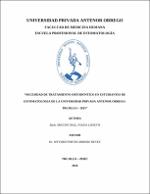Necesidad de tratamiento ortodóntico en estudiantes de Estomatología de la Universidad Privada Antenor Orrego Trujillo - 2015

Ver/
Descargar
(application/pdf: 463.5Kb)
(application/pdf: 463.5Kb)
Fecha
2016Autor(es)
Irigoin Diaz, Joana Lisseth
Metadatos
Mostrar el registro completo del ítemResumen
El objetivo del presente trabajo de investigación fue determinar la necesidad de tratamiento
Ortodóntico en estudiantes de Estomatología de la Universidad Privada Antenor Orrego. El
segundo objetivo fue determinar la necesidad de tratamiento de ortodoncia de acuerdo al sexo y
la edad.
Se seleccionaron 100 estudiantes (29 varones y 71 mujeres) en el año 2015, la edad promedio fue
de 18 a 25 años. Para ello, se hizo uso del Índice Estético Dental (DAI) por ser un índice que
relaciona la maloclusion con la necesidad de tratamiento.
Los resultados mostraron que la puntuación promedio del DAI fue 34.79 puntos. Se determinó
que el 20.00 % presento maloclusion leve u oclusión normal y el 80% restante presentaron: 34%
maloclusion severa, con un tratamiento ortodóntico recomendable y un 46% maloclusion muy
severa, con tratamiento ortodóntico obligatorio. El apiñamiento dental en una o ambos maxilares
fue el signo de maloclusion más común que se encontró. The objective of this research was to determine the need for orthodontic treatment in students of
Stomatology of the Antenor Orrego Private University. The second objective was to determine the
need for orthodontic treatment according to sex and age.
One hundred students were selected in 2015 (29 males and 71 females). The average age was 18
to 25 years. The Dental Aesthetic Index (DAI) was used for being an index that relates
malocclusion with the need for treatment.
The results showed that the mean DAI score was 34.79 points; 20.00% of the test subjects had
mild malocclusion or normal occlusion, and out of the remaining 80%, 34.00% presented severe
malocclusion to which orthodontic treatment would be recommended, and 46% presented very
severe malocclusion, requiring mandatory orthodontic treatment. Dental crowding in one or both
jaws was the most common malocclusion sign found.
Palabras clave
Colecciones
- Estomatología [653]

